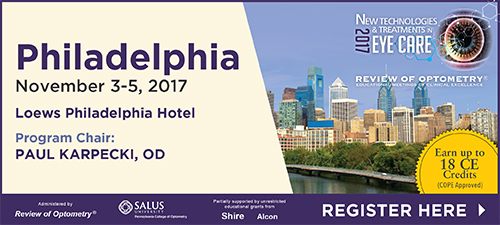
A
weekly e-journal by Art Epstein, OD, FAAO
Off the Cuff: Wearables: A Glimpse Into the Future
The future looms ever closer, and its challenges seem ever greater. In eye care, we balance on the precipice of incredible change. Advances in technology have given us unprecedented power to diagnose and treat patients, but when misused or abused, threaten the public health and even our own existence. As I’ve opined many times here, we need to be at the forefront of technology if we are to survive and fulfill our mandate of caring for patients above all else.
|
|||||
|
|||
| Evaluation of Macular Perfusion in Healthy Smokers By Using OCTA | ||||
This study investigated the macular perfusion changes in healthy smokers by using optical coherence tomography angiography (OCTA). OCTA measurements were taken for the right eyes of 40 smokers (group 1) and age- and sex-matched control cases (group 2). Group 1 underwent OCTA scanning with the XR Avanti AngioVue OCTA (Optovue) at baseline and at five, 30 and 60 minutes after smoking one standard cigarette. The same scanning protocol was applied without smoking in group 2. Macular vessel area density, flow index of the choriocapillaris, foveal avascular zone (FAZ) and central macular thickness were evaluated in both groups.
Group 1 consisted of 28 men and 12 women with a mean age of 41.2 ± 9.1 years (range: 24 to 63 years). The mean age of group 2, consisting of 28 men and 12 women, was 42.6 ± 8.4 years (range: 21 to 65 years). The mean baseline vessel area density, flow index of the choriocapillaris, FAZ and central macular thickness showed no statistically significant differences between groups 1 and 2. Although the flow index of choriocapillaris values were similar at the repetitive OCTA measurements in the control group, it was decreased from 1.94 ± 0.06 to 1.89 ± 0.08, 1.90 ± 0.08 and 1.91 ± 0.07 at five, 30 and 60 minutes following smoking, respectively, in group 1. Researchers determined that smoking caused a significant decrease in the blood flow index of the choriocapillary area as a result of the acute effects of nicotine and other chemical substances in cigarettes on peripheral vascular structure, as evaluated by OCTA. |
||||
SOURCE: Ayhan Z, Kaya M, Ozturk T, et al. Evaluation of macular perfusion in healthy smokers by using optical coherence tomography angiography. Ophthalmic Surg Lasers Imaging Retina. 2017;48(8):617-22. |
||||
|
|||
| Estimates of Retinal Ganglion Cell Counts Performed Better Than Isolated Structure and Functional Tests for Glaucoma Diagnosis | ||||
This study evaluated the diagnostic accuracy of retinal ganglion cell (RGC) counts as estimated by combining data from standard automated perimetry (SAP) and spectral-domain optical coherence tomography (SD-OCT). Healthy individuals and glaucoma patients were included in this cross-sectional study. All eyes underwent 24-2 SITA SAP and structural imaging tests. RGC count estimates were obtained using a previously described algorithm that combines estimates of RGC numbers from SAP sensitivity thresholds and SD-OCT retinal nerve fiber layer (RNFL) average thickness.
A total of 119 eyes were evaluated, including 75 eyes of 48 healthy individuals and 44 eyes of 29 glaucoma patients. RGC count estimates performed better than data derived from SD-OCT RNFL average thickness or SAP mean deviation alone (area under ROC curves: 0.98, 0.92 and 0.79) for discriminating healthy from glaucomatous eyes, even in a subgroup of eyes with mild disease (0.97, 0.88 and 0.75). Investigators found a strong and significant correlation between estimates of RGC numbers derived from SAP and SD-OCT (R2=0.74). Investigators concluded that RGC count estimates obtained by combined structural and functional data showed excellent diagnostic accuracy for discriminating healthy from glaucomatous eyes, and performed better than isolated structural and functional parameters. |
||||
SOURCE: Esporcatte BLB, Kara-José AC, Melo LAS Jr, et al. The estimates of retinal ganglion cell counts performed better than isolated structure and functional tests for glaucoma diagnosis. J Ophthalmol. 2017; Jul 24. [Epub ahead of print]. |
||||

|
||
| Comparing the Effects of Two Different Contact Lenses on Corneal Re-epithelialization After Corneal Collagen Crosslinking | ||||
This study investigated whether keratoconus (KC) patients who applied corneal collagen crosslinking (CXL) and two different contact lens (CL) showed any differences in complaints and findings following CXL. This prospective, comparative, double-blind clinical study involved 60 eyes of 60 patients (38 female and 22 male). At the end of the CXL procedure, CL (balafilcon A) was inserted into 29 patients (group 1), while CL with different material content (hioxifilcon A) designed for therapeutic/bandage purposes was inserted into 31 patients (group 2).
On the first and third day after CXL, no statistically significant differences between the groups could be found in terms of postoperative symptoms. On the third day after CXL, all cases in both groups completed the corneal re-epithelialization. A greater PE ratio was found in the patients who had allergic conjunctivitis. With the use of balafilcon A and hioxifilcon A lens materials, KC patients who underwent CXL were found to have similar symptoms and clinical findings after the procedure. However, epithelial staining and PE were more frequent in KC cases accompanied by allergic conjunctivitis. |
||||
SOURCE: Kocluk Y, Cetinkaya S, Sukgen EA, et al. Comparing the effects of two different contact lenses on corneal re-epithelialization after corneal collagen cross-linking. Pak J Med Sci. 2017;33(3):680-5. |
||||
 |
||
| News & Notes | ||||||||
| Shire Submits Lifitegrast MAA for DED Treatment in Europe Shire announced that its Marketing Authorization Application for lifitegrast, submitted in August, was validated by the UK. If approved, lifitegrast would be the first treatment in a new class of drugs (LFA-1 antagonist) to address the signs and symptoms of dry eye disease in adults in Europe. Shire’s MAA for lifitegrast is supported by a development program consisting of five clinical trials with more than 2,500 individuals. In these studies, signs of dry eye disease were measured using corneal staining, and symptoms were assessed by patient-reported eye dryness scores. Read more.
|
||||||||
Academies & CDC Promote Healthy Contact Lens Wear |
||||||||
| BioTime Receives $2 Million Grant for OpRegen Development BioTime was awarded a grant of approximately $2 million from the Israel Innovation Authority for continued development of OpRegen, which is part of a Phase I/IIa dose-optimization clinical trial evaluating the safety and efficacy of its implantation regimens in the treatment of advanced dry AMD. OpRegen consists of a suspension of retinal pigment epithelial cells delivered subretinally during an intraocular injection. Data reported to date have shown continued engraftment through one-year follow-up with encouraging potential structural improvement. In addition, no serious adverse events have been reported. Read more.
|
||||||||
|
Optometric Physician™ (OP) newsletter is owned and published by Dr. Arthur Epstein. It is distributed by the Review Group, a Division of Jobson Medical Information LLC (JMI), 11 Campus Boulevard, Newtown Square, PA 19073. HOW TO ADVERTISE |





